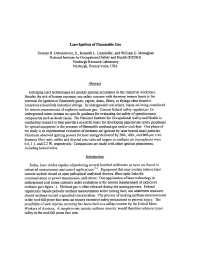Mining Publication: Laser Ignition of Flammable Gas
Original creation date: March 1999
Emerging laser technologies are quickly gaining acceptance in the workplace. Besides the risk of human exposure, one safety concern with the more intense lasers is the potential for ignition of flammable gases, vapors, dusts, fibers, or flyings often found in hazardous (classified) industrial settings. In underground coal mines, lasers are being considered for remote measurement of explosive methane gas. Current federal safety regulations for underground mines contain no specific guidance for evaluating the safety of optoelectronic components such as diode lasers. The National Institute for Occupational Safety and Health is conducting research to help provide a scientific basis for developing appropriate safety guidelines for optical equipment in the presence of flammable methane gas and/or coal dust. One phase of the study is an experimental evaluation of methane-air ignition by laser heated small particles. Minimum observed igniting powers for laser energy delivered by 200-, 400-, and 800-micro m core diameter fiber optic cables and directed onto selected targets in methane-air atmospheres were 0.6, 1.1, and 2.2 W, respectively. Comparisons are made with other ignition phenomena including heated wires.
Authors: TH Dubaniewicz, KL Cashdollar, WD Monaghan
Conference Paper - March 1999
NIOSHTIC2 Number: 20024431
Proc International Laser Safety Conference, 1999, Orlando, Florida: Laser Institute of America, 1999 Mar; :309-318
See Also
- The Brookwood Disaster and Electrical Requirements for Hazardous (Classified) Locations
- Coal Dust and Methane
- Continuous Wave Laser Ignition Thresholds of Coal Dust Clouds
- Ignition of Methane-Air Mixtures by Laser Heated Small Particles
- Lasers
- Lightning Propagation Through the Earth and its Potential for Methane Ignitions in Abandoned Areas of Underground Coal Mines
- Methane-Air Mixtures Ignited by CW Laser-Heated Targets on Optical Fiber Tips: Comparison of Targets, Optical Fibers, and Ignition Delays
- NIOSH Research for Monitoring and Controlling Methane at U.S. Underground Coal Mining Operations
- Technology News 530 - Frictional Ignition of Methane-Air in the Presence of Liquid Hydrocarbons
- Threshold Powers and Delays for Igniting Propane and Butane-Air Mixtures by CW Laser-heated Small Particles
- Page last reviewed: 9/21/2012
- Page last updated: 9/21/2012
- Content source: National Institute for Occupational Safety and Health, Mining Program


 ShareCompartir
ShareCompartir
